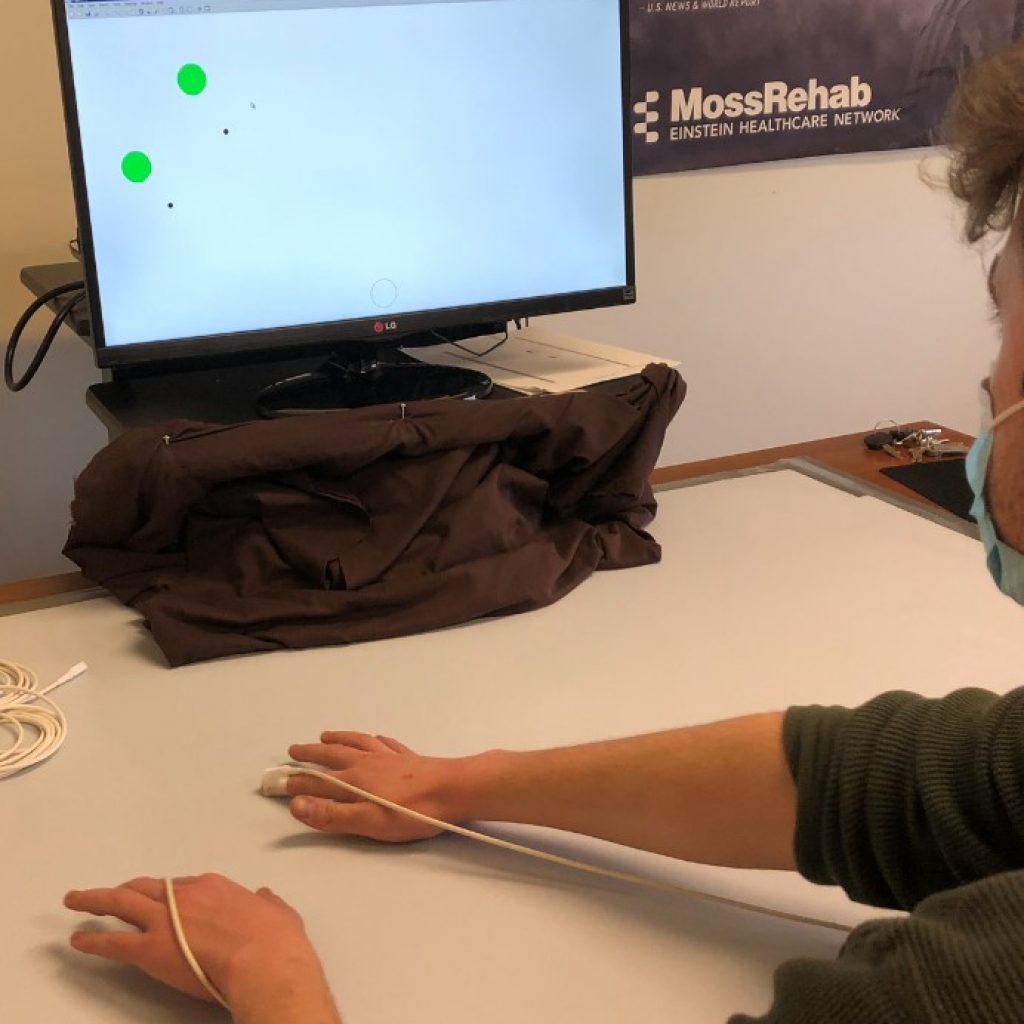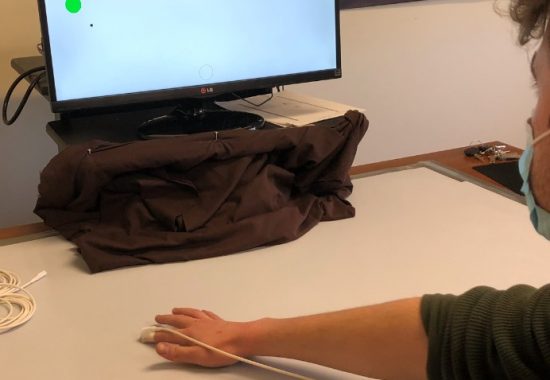
The ability to plan and perform movements is typically taken for granted in healthy people. Actions feel as though they happen automatically while individuals attend to other ‘higher level’ matters, like how to reply to an email or what to eat for dinner. But the ease with which movements usually occur masks the rich cognitive mechanisms that underlie even the most basic actions. When movement planning is disrupted due to stroke or injury, the profound consequences to health and wellbeing that can follow reveal the critical importance and daunting complexity of these processes. Research projects conducted by Moss Rehabilitation Research Institute (MRRI) scientists Cory Potts, PhD, Laurel Buxbaum, PsyD, Shailesh Kantak, PT, PhD, and Aaron Wong, PhD, are focused on understanding interactions between cognition and action with the broader goal of gaining insight into how to help individuals with disordered movement.
Following a stroke, 80% of individuals show reduced ability and use of one arm. Most daily activities involve bimanual action, or the coordinated use of both arms. Thus, the reduced use of one arm can severely impact survivors’ independence and quality of life. While previous research has examined use of the affected or the unaffected arm during unimanual action (movement with one arm), virtually nothing is known about how stroke survivors choose between using one or both arms for daily tasks. In a new research project, Drs. Potts, Buxbaum, and Kantak will investigate, for the first time, task-related and clinical variables that influence the use of one or both arms in individuals with chronic stroke (Fig. 1). These MRRI scientists hope that the insights gained from this work can guide the development of rehabilitative strategies that ultimately promote use of the affected arm.
The clinical importance of this work is highlighted by research suggesting that the use and ability of the weaker arm is improved during bimanual action in stroke survivors. Important daily activities such as cooking, bathing, and performing housework can be performed more effectively using both arms together compared to either arm alone. Additionally, research recording patients’ arm movement in their daily lives has suggested that use of the weaker arm happens almost exclusively during bimanual action, when the weaker arm can be used together with the unaffected arm. These findings suggest important and clinically relevant differences in the control and mechanisms that underlie bimanual compared to unimanual action.
In related work, Drs. Potts and Kantak are examining the planning and coordination of bimanual actions in stroke patients. Efficient movement planning involves adjusting for the physical properties of objects. Here, researchers tested how well stroke patients and adults without stroke (controls) could adjust for changes in an object’s weight. In the experiment, participants lifted a box that was initially unweighted. After a few lifts, unbeknownst to the participant, weight was added to the box. Drs. Potts and Kantak were interested in how the additional weight would affect forthcoming movements. The results suggested interesting planning differences between control participants and stroke survivors. After feeling the increased weight of the box, neurotypical controls incorporated the information into the forthcoming movement plan, scaling the force applied to the box before liftoff. Stroke patients, on the other hand, showed a more reactive pattern, adjusting the force applied to the box throughout the movement. These results illustrate how differences in low-level features of movement—the physical forces applied to an object—can offer a window of insight into changes in movement planning following stroke. Additionally, pinpointing the differences between movement planning in healthy individuals and stroke survivors may inform training strategies to improve movement capacity.
A final line of work is aimed at understanding issues with gesture imitation in apraxia—a disorder of intentional action most commonly associated with left hemisphere stroke. Individuals with apraxia often show difficulties imitating gestures. Imagine that a coach is showing a player how to throw a ball through gesture. There are two strategies the player might take to reproduce the gesture. The player could recreate the pathway of the coach’s hand through space. Alternatively, the player could recreate the position of the coach’s hand relative to other arm joints—where the hand is located in relation to the elbow, for example. Researchers at MRRI are testing whether the latter strategy—replicating specific joint positions—is especially difficult for individuals with apraxia. The foundation for this hypothesis is that a common site of damage in apraxia, the left parietal lobe, plays an important role in the ability to store and update the position of the body.
To test this hypothesis, Drs. Potts, Buxbaum, and Wong asked age-matched controls and individuals with left-hemisphere stroke to imitate meaningless gestures. To encourage participants to attend to their joint positions, the scientists distorted some of the gestures such that successful imitation required unnatural arm joint positions. Imagine, for example, that the coach in our previous example has their elbow in an inefficient position above their hand when showing how to throw the ball, forcing the player to attend to their own elbow during imitation. While this research is ongoing, the results are encouraging. The data suggest that individuals with apraxia have difficulty reproducing inefficient arm joint positions compared to controls, consistent with the notion that this joint-centered route to imitation is particularly difficult. Though it is unlikely that patients will encounter this precise task in their daily lives, the results have implications for rehabilitation strategies—for example, it might be best to avoid joint-focused instructions during therapeutic interventions (e.g., “keep the elbow in line with the shoulder”). Moreover, these findings add yet another small piece to the expansive puzzle that is movement planning.


One comment on “Dr. Cory Potts Aims To Get a Grasp on Cognition and Action”